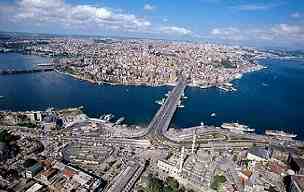
Latest News
New openings
The Zeyrek Cistern is opened to visits after years of restorations.
Entrance fees
As of 2026, Palace museums' entrance fees are raised.
Museum Pass
You can buy the "Museum Pass" for foreigners which is valid for 5 days in various museums of Istanbul.
Museums open 7 days
Many State museums in Istanbul operate 7 days a week, except Topkapi Palace.
Galata Bridge in Istanbul
 The oldest recorded bridge over the Golden Horn was built as a simple one in 1453 during the Turkish siege of the city. In the beginning of 16th century it was decided to build a permanent bridge here and Leonardo da Vinci designed a single span bridge with double pillars at either end, 250 meters long, 8 meters wide and
24 meters high. However, technical drawbacks made it impossible to realize this
project. Than another Italian artist, Michelangelo, was invited to design
a bridge for Istanbul but he rejected
the proposal, and the idea of building a bridge on the Golden Horn was shelved until
the 19th century. In the early 19th century sultan Mahmut II (1808-1839) had a
bridge built at some distance up the waterway between Azapkapi and Unkapani.
This bridge, known as the Hayratiye, was opened on 3 September 1836. The
project was carried out by Deputy Lord High Admiral Fevzi Ahmet Pasa using
the workers and facilities of the naval arsenal. The bridge was built on linked pontoons and was around 500 to
540 meters long.
The oldest recorded bridge over the Golden Horn was built as a simple one in 1453 during the Turkish siege of the city. In the beginning of 16th century it was decided to build a permanent bridge here and Leonardo da Vinci designed a single span bridge with double pillars at either end, 250 meters long, 8 meters wide and
24 meters high. However, technical drawbacks made it impossible to realize this
project. Than another Italian artist, Michelangelo, was invited to design
a bridge for Istanbul but he rejected
the proposal, and the idea of building a bridge on the Golden Horn was shelved until
the 19th century. In the early 19th century sultan Mahmut II (1808-1839) had a
bridge built at some distance up the waterway between Azapkapi and Unkapani.
This bridge, known as the Hayratiye, was opened on 3 September 1836. The
project was carried out by Deputy Lord High Admiral Fevzi Ahmet Pasa using
the workers and facilities of the naval arsenal. The bridge was built on linked pontoons and was around 500 to
540 meters long.
The first Galata Bridge at the entrance of the Golden Horn was constructed in 1845 by the mother of Sultan Abdulmecid and used for 18 years. It was known as the Cisr-i Cedid or New Bridge to distinguish it from the earlier bridge further up the Golden Horn, which became known as the Cisr-i Atik or Old Bridge.
The New Bridge was built by Abdulmecid Han. First to pass over the bridge was Sultan Abdulmecid, and the first to pass below it was the French captain Magnan in his ship the Cygne. For the first three days crossing the bridge was free, after which a toll known as mürüriye was paid to the Naval Ministry.
This was replaced by a second wooden bridge in 1863, built by Ethem Pertev Pasha on the orders of Sultan Abdulaziz in readiness for the visit to Istanbul of Napoleon III.
In 1870 a contract was signed with a French company, Forges et Chantiers de la Mediteranée for construction of a third bridge, but the outbreak of war between France and Germany delayed the project, which was given instead to a British firm G. Wells in 1872. This bridge completed in 1875 was 480 m long and 14 m wide and rested on 24 pontoons. It was built at a cost of 105,000 gold liras. This was used until 1912, when it was pulled upstream to replace the now genuinely old Cisr-i Atik Bridge.
The fourth Galata Bridge was built in 1912 by the German Man firm for 350,000 gold lira. This bridge was 466 m long and 25 m wide. It is the bridge still familiar to many people today that was badly damaged in a fire in 1992 and towed up the Golden Horn to make way for the modern bridge now in use.
The Galata Bridge was a symbolic link between the old Istanbul at Eminonu neighborhood, site of the imperial palace and principal religious and secular institutions of the Ottoman Empire, and the districts of Galata, Beyoglu, Sisli and Harbiye where a large proportion of the inhabitants were non-Muslims and where foreign merchants and diplomats lived and worked. In this respect the bridge connected these two distinctive cultures. As Peyami Safa said in his novel Fatih-Harbiye, a person who went from Fatih (in the old part) to Harbiye (in the new part) via the bridge set foot in a different civilization and different culture. Apart from its place in fiction, the romantic appearance of the Galata Bridge made it a subject of many paintings and engravings.
Today, the modern Galata Bridge has several restaurants and coffee houses underneath where local people enjoy their meal watching the rush of the ferry boats and fishermen. All daily city tours in Istanbul include this bridge as it's the passageway to the Old City of Constantinople. And the old bridge is now located deeper in the Golden Horn, between Sutluce and Feshane Convention and Fair centers.
Hope to see you soon in Istanbul.

